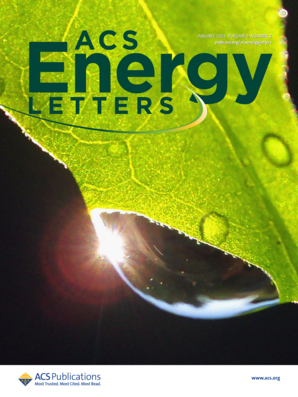湿稳定钙钛矿/硅串联太阳能电池与内部封装的硫基分子
IF 19.3
1区 材料科学
Q1 CHEMISTRY, PHYSICAL
引用次数: 0
摘要
工业结构钙钛矿/硅串联太阳能电池是未来低成本光伏部署最有前途的候选者之一。空气退火是制备高质量钙钛矿薄膜的必经工艺。然而,由于受潮和高温,这一过程往往会导致表面严重的钙钛矿分解。为了解决这一问题,在有机盐溶液中加入稳定添加剂二甲基苯乙基碘化磺酸(DMPESI),形成疏水的内部包封层。结果表明,在空气退火过程中,钙钛矿的表面分解被有效抑制,得到的钙钛矿薄膜的稳定性和质量显著提高。因此,工业结构钙钛矿/硅串联太阳能电池提供了30.49% (1.21 cm2)的令人印象深刻的效率。此外,封装串联器件在近1800小时的最大功率点跟踪(MPPT) (iso - l -1)和723小时的湿热测试(iso - d -3)后保持了84%的初始效率。本文章由计算机程序翻译,如有差异,请以英文原文为准。

Damp-Stable Perovskite/Silicon Tandem Solar Cells with Internal Encapsulating Sulfonium-Based Molecules
Industrially textured perovskite/silicon tandem solar cells are among the most promising candidates for future low-cost photovoltaic deployment. Air-annealing is an inevitable process to fabricate high-quality perovskite films during the hybrid two-step deposition method. However, this process often leads to severe perovskite decomposition on the surface because of moisture exposure and high-temperature. To address this issue, a stabilizing additive─dimethylphenethylsulfonium iodide (DMPESI)─is introduced into the organic salt solution, forming a hydrophobic internal encapsulation layer. As a result, the perovskite surface decomposition is effectively suppressed during the air-annealing process and the resulting perovskite films exhibit significantly enhanced film stability and quality. Consequently, the industrially textured perovskite/silicon tandem solar cells delivered an impressive efficiency of 30.49% (1.21 cm2). Moreover, encapsulated tandem devices retained 84% of their initial efficiency after nearly 1800 h of maximum power point tracking (MPPT) (ISOS-L-1) and 80% after 723 h of damp heat test (ISOS-D-3).
求助全文
通过发布文献求助,成功后即可免费获取论文全文。
去求助
来源期刊

ACS Energy Letters
Energy-Renewable Energy, Sustainability and the Environment
CiteScore
31.20
自引率
5.00%
发文量
469
审稿时长
1 months
期刊介绍:
ACS Energy Letters is a monthly journal that publishes papers reporting new scientific advances in energy research. The journal focuses on topics that are of interest to scientists working in the fundamental and applied sciences. Rapid publication is a central criterion for acceptance, and the journal is known for its quick publication times, with an average of 4-6 weeks from submission to web publication in As Soon As Publishable format.
ACS Energy Letters is ranked as the number one journal in the Web of Science Electrochemistry category. It also ranks within the top 10 journals for Physical Chemistry, Energy & Fuels, and Nanoscience & Nanotechnology.
The journal offers several types of articles, including Letters, Energy Express, Perspectives, Reviews, Editorials, Viewpoints and Energy Focus. Additionally, authors have the option to submit videos that summarize or support the information presented in a Perspective or Review article, which can be highlighted on the journal's website. ACS Energy Letters is abstracted and indexed in Chemical Abstracts Service/SciFinder, EBSCO-summon, PubMed, Web of Science, Scopus and Portico.
 求助内容:
求助内容: 应助结果提醒方式:
应助结果提醒方式:


